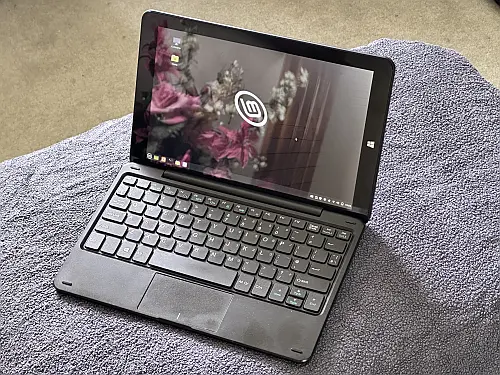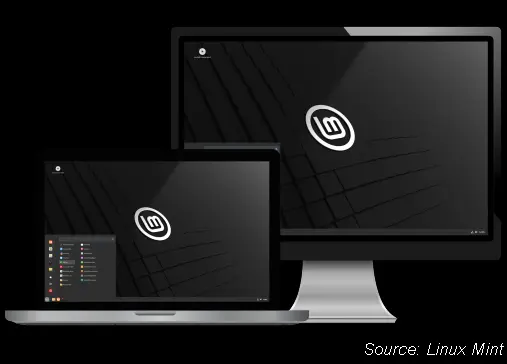Most of us use a computer running Microsoft Windows for work – I do – some of us use an Apple Mac or a Chromebook and an even smaller number use a computer not running one of those mainstream operating systems – Linux.
Linux has a major advantage when it comes to using it in the office – basically it is free. So the question is does Linux have a place in your business?
We all have older hardware, tucked away in a cupboard, that still has life in it but technology and operating system versions have overtaken it and now it is retired.
That is what happened to me. We had a surplus Linx 10 hybrid small notebook/tablet, that came with Windows 8 and had Windows 10 crowbarred into the 32GB of storage and 2GB of RAM – it was also 32bit. I had an idea to upcycle it into a portable Linux machine for some cyber security tasks and some light work when on the road without my main laptop.

So Ben got the job of making it happen. He fixed the OS, then it was up to me to see if it would be useable.
What flavour of Linux?
Unlike Microsoft Windows, MacOS and Chrome, which are proprietary operating systems (OS) aimed at specific hardware, Linux is open-source and can be made to run on a wide variety of hardware – if you wanted to and had the skills you could create your own version of Linux from the open source code.
Many people and organisations have done that. Linux versions vary widely – some are general purpose operating systems for desktops, many are for servers, and some are for very specialised tasks. I have a “run from memory stick” version for cyber security work. Some are not well supported or niche. Finding one that will work on your hardware can also be an issue. And there are paid-for versions.
Hence – what flavour Linux would be appropriate for this job?
Mint – Linux that gives you a “Windows” experience
After some research, Ben chose Linux Mint as it gives a Windows-like experience and can be deployed via some technical wizardry on a 32bit machine so it works with my hardware. As a bonus it can also be delivered to me with the “out of the box” experience. What that means is that when I started it up, I chose my own username, password, language etc., and Ben’s setup and engineering accounts were gone.
I have previous experience with a number of versions of Linux and I am comfortable using the command line – something that often puts users off trying Linus out – but this version of Linux does not use the command line for the regular user. The learning curve for Linux Mint is very shallow and easily mastered by most people who can use Windows.
However it was not all plain sailing.
There was (is) the minor irritation of the screen orientation during the initial setup, but once the machine is rebooted it remembers the desktop orientation on log-in!
Also I had to try three different HP printer drivers before I got the one that worked correctly – and it was not technical expertise that got me there but trial and error, so you could have done that as well.
Hardware
Hardware – everything worked except the built in camera, tablet mode and the “\” key, which was not mapped because of the condensed keyboard (this can be sorted out by pressing alt and 92).
It found a drivers for my Bluetooth mouse and the touchscreen.
The real bonus is that Linux Mint OS and installed apps have light hardware resource requirements, which my limited and older hardware copes with easily. It is a now snappy quick machine – probably quicker than when it was running Microsoft Windows.
Light Work
So what can I do with this very portable laptop.
- The cyber security tools work.
- I can access my business Microsoft 365 and use the web apps. This includes having to Authenticate each login, a good cyber security precaution. I do not use my Global Administrator account on this machine.
- I can use Teams using a separate app. There is no video as the front camera is not recognised but everything else works.
- I can use the Libre Office that comes installed with the OS for office tasks if I am offline and I can save the files as Microsoft 365 compatible versions, uploading them to OneDrive or SharePoint using the web apps when I am back online.
- I have a fully functional printer driver for our HP LaserJet including the duplexer.
- I can log in and update WordPress websites – I do not use my administrator accounts, only my editor accounts as another cyber security precaution.
- I can play music and videos – there are always evenings in the hotel!
I also stripped off all the apps I will not use – as I did not want to have to keep them updated and it freed up storage space.
Cyber Security
Cyber security is going to be covered in part 2 of this article – which you will find over on Smart Thinking Solutions.
Clive Catton MSc (Cyber Security) – by-line and other articles


